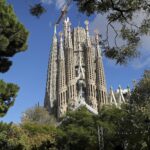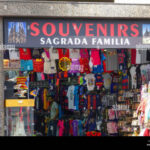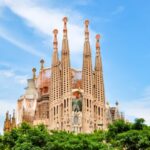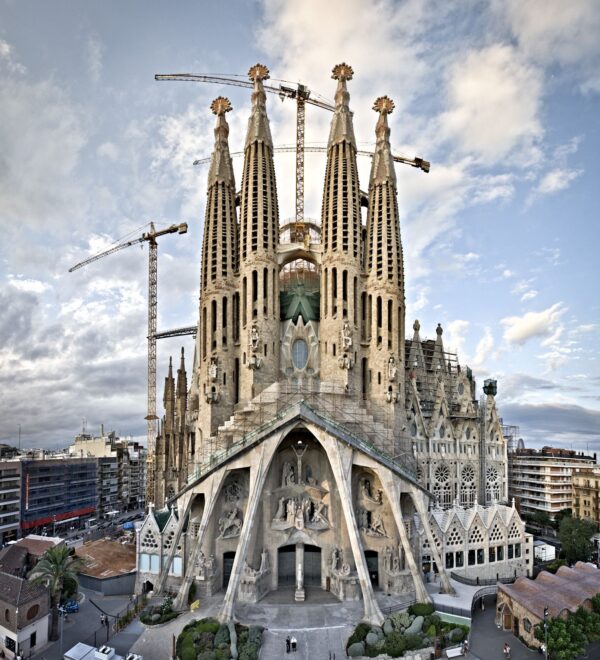
The Sagrada Familia, an iconic masterpiece designed by the renowned architect Antoni Gaudí, stands as one of Barcelona's most remarkable landmarks. Its intricate details and unique design have captivated millions of visitors from around the world, making it a symbol of the city's rich cultural heritage.
As construction continues on this architectural wonder, there are countless stories and intriguing details waiting to be uncovered. In this article, we invite you to Discover the Fascinating Facts about Sagrada Familia in Barcelona, Spain, exploring its history, significance, and the innovative techniques that define this extraordinary basilica.
The Architectural Marvel of Sagrada Familia: A Deep Dive
The Sagrada Familia is not just a church; it is a testament to innovation in architectural design. Gaudí's vision combined Gothic and Art Nouveau styles, resulting in a structure that defies traditional conventions. This architectural marvel is characterized by its soaring towers, intricate facades, and organic forms that mimic nature, creating a harmonious relationship with its surroundings.
One of the most fascinating aspects of the Sagrada Familia is its symbolism. Each of the 18 towers represents a significant biblical figure, including the Virgin Mary, the apostles, and Jesus Christ. The tallest tower, dedicated to Jesus, is designed to reach 172.5 meters, making it the highest church tower in the world. This thoughtful integration of religion and design is what makes the basilica a landmark of spiritual significance.
Moreover, Gaudí's use of light plays a crucial role in the Sagrada Familia's allure. The stained glass windows are designed to filter sunlight in a way that enhances the interior's atmosphere, producing stunning visual effects throughout the day. This technique not only beautifies the space but also symbolizes divine light and enlightenment.
- Architectural Style: A blend of Gothic and Art Nouveau
- Tower Count: 18 towers representing biblical figures
- Height of Main Tower: 172.5 meters, the tallest in the world
- Stained Glass: Designed to maximize natural light
Uncovering the History Behind Sagrada Familia in Barcelona
The Sagrada Familia's history dates back to its inception in 1882, when construction began under the direction of architect Francisco de Paula del Villar. However, it was Antoni Gaudí who took over the project a year later, transforming the original design into a visionary masterpiece. His deep religious faith and passion for nature heavily influenced his architectural choices, leading to a creation that is both a church and a work of art.
Throughout its long history, the Sagrada Familia has been a symbol of perseverance. The construction was interrupted by various events, including the Spanish Civil War, which led to the destruction of many of Gaudí's original plans. Despite these setbacks, the project has persisted, with dedicated teams working tirelessly to fulfill Gaudí's vision. Today, the basilica is expected to be completed in the coming decades, forever evolving while preserving its historical roots.
The Sagrada Familia is not just a local treasure; it holds global significance as a UNESCO World Heritage Site. This designation highlights the basilica’s architectural innovation and its representation of a unique artistic vision that transcends time. It stands as a beacon of cultural heritage, attracting visitors who come to admire its breathtaking beauty and rich history.
As we delve deeper into the history of this iconic building, we uncover layers of cultural influence and artistic endeavor, making the Sagrada Familia a marvel not only of construction but also of human spirit and creativity. Here are some key historical milestones:
- 1882: Construction begins under Francisco de Paula del Villar.
- 1883: Antoni Gaudí becomes the principal architect.
- 1936: Construction halted due to the Spanish Civil War, resulting in the loss of many plans.
- 2026: Projected completion date, marking 100 years since Gaudí's death.
Significance of Sagrada Familia: A Symbol of Catalan Identity
The Sagrada Familia serves as a powerful emblem of Catalan identity, reflecting the region's rich cultural and historical heritage. Its construction, fueled by local pride and artistic innovation, showcases the strength of Catalan nationalism, particularly during times of political and social upheaval. As a result, this architectural wonder is not merely a religious site; it embodies the aspirations and resilience of the Catalan people.
Moreover, the Sagrada Familia has become a symbol of unity among Catalans. It acts as a focal point for various cultural and religious celebrations, drawing people from diverse backgrounds to participate in communal events. This inclusivity reinforces the idea that the basilica stands not only for faith but also for a collective identity that transcends individual differences.
Key aspects of the Sagrada Familia's significance as a symbol of Catalan identity include:
- Cultural Heritage: Represents the artistic legacy of Catalan Modernisme.
- National Pride: Reflects the determination to continue Gaudí's vision despite challenges.
- Community Engagement: Hosts events that strengthen the bond among locals and visitors alike.
- Political Symbolism: Stands as a testament to Catalan autonomy and identity.
In essence, the Sagrada Familia is a living monument that encapsulates the spirit of Catalonia. Its intricate designs and enduring construction process mirror the region's ongoing quest for cultural recognition and independence, making it not just a site of architectural beauty but a profound statement of identity and belonging.
Exploring the Unique Design Elements of Sagrada Familia
The unique design elements of the Sagrada Familia are integral to its status as a modern architectural marvel. Gaudí's innovative approach to structure and form is evident in the basilica's organic shapes that mimic natural forms. This design philosophy not only enhances the aesthetic appeal but also promotes structural integrity, allowing the building to withstand the test of time. Elements such as the hyperboloid shapes in the columns and the parabolic arches create a stunning visual experience that captivates visitors.
Another remarkable feature of the Sagrada Familia is its attention to detail, particularly in its facades. Each façade tells a different story, reflecting various biblical events and figures. The Nativity Facade, for instance, is adorned with intricate sculptures depicting the birth of Jesus, while the Passion Facade illustrates the crucifixion with stark, somber figures. This storytelling aspect through architecture invites visitors to engage with the narrative of the basilica on multiple levels.
Moreover, Gaudí's use of light is a defining element in the Sagrada Familia's design. The strategic placement of windows and the use of colored glass not only filter sunlight but also create a dynamic and ethereal atmosphere within the church. As the sun moves across the sky, the changing light patterns interact with the interior space, enhancing the spiritual experience for those who enter.
- Organic Design: Structures mimic natural forms for both aesthetics and strength.
- Facial Narratives: Each façade represents different biblical stories.
- Light Play: Stained glass windows create an ever-changing ambiance.
- Symbolic Elements: Architectural features embody spiritual and cultural significance.
Visiting Sagrada Familia: Tips and Must-See Highlights
When visiting the Sagrada Familia, planning ahead can greatly enhance your experience. It is advisable to purchase your tickets online in advance to avoid long queues. Consider opting for a guided tour, which not only provides you with valuable insights into Gaudí's vision but also helps you navigate the basilica's intricate details. Timing your visit during off-peak hours can also result in a more serene atmosphere for exploration.
Don't miss the opportunity to marvel at the basilica's three stunning façades: the Nativity, Passion, and Glory. Each façade presents a unique narrative, showcasing Gaudí's artistic interpretation of biblical events. The Nativity Façade, with its intricate sculptures, celebrates the birth of Christ, while the Passion Façade portrays the somber moments of crucifixion. Be sure to take your time to absorb the stories embedded in these magnificent designs.
Another highlight is the breathtaking interior, where Gaudí's use of light and color creates an enchanting atmosphere. The stained glass windows filter sunlight into a spectrum of colors, transforming the space throughout the day. Ascend the towers for a panoramic view of Barcelona, but remember that access may require a separate ticket and can be limited by weather conditions. Planning your visit with these highlights in mind will ensure you make the most of your time at this architectural wonder.
Finally, consider visiting the Sagrada Familia during special events, such as Mass or concerts, to experience its spiritual ambiance. Engaging with the local context enhances your visit, as the basilica often hosts community events that reflect Catalan culture. Embrace the opportunity to witness not only an architectural feat but also a living symbol of Catalan identity and community spirit.
The Ongoing Construction of Sagrada Familia: What You Need to Know
The ongoing construction of the Sagrada Familia remains a captivating journey, intertwining the historical vision of Antoni Gaudí with modern advancements in architecture. Expected to be completed by 2026, this ambitious timeline marks a century since Gaudí's death, further solidifying its significance as a tribute to his genius. The project relies on a dedicated team of architects, craftsmen, and engineers who strive to preserve Gaudí’s original designs while incorporating contemporary techniques.
One of the key factors driving the construction forward is the innovative use of technology. Modern tools such as 3D modeling and computer-aided design are utilized to interpret Gaudí’s intricate plans, which were initially drawn by hand. This blend of old and new techniques has allowed for more accurate and efficient construction processes. Notable advancements include:
- Robotic Stone Cutting: Enhances precision in creating complex stone carvings.
- Virtual Reality: Provides immersive experiences that help architects visualize the completed structure.
- Sustainable Practices: Incorporates environmentally friendly materials and techniques to minimize impact.
Despite the challenges posed by external factors, like the COVID-19 pandemic, the project has continued with remarkable resilience. Funding primarily comes from ticket sales, donations, and the support of the local community, which remains deeply invested in the basilica's completion. The construction not only aims to deliver an architectural masterpiece but also serves as a beacon of hope and unity, reflecting the determination of both Barcelona and its citizens.
The Sagrada Familia's ongoing construction also emphasizes the importance of education and outreach. Visitors play an integral role in this journey by learning about the basilica's history and the intricate processes involved in its development. Engaging with the project through guided tours and exhibitions helps to foster a deeper appreciation for this landmark, ensuring that its legacy continues for generations to come.
 The Magnificent Sagrada Familia in Barcelona, Spain: A Pictorial Journey
The Magnificent Sagrada Familia in Barcelona, Spain: A Pictorial Journey Discover the Perfect Souvenirs at the Sagrada Familia Barca Store in Barcelona
Discover the Perfect Souvenirs at the Sagrada Familia Barca Store in Barcelona From Sagrada Familia to Barcelona Sants: Exploring Barcelona's Architectural Marvels
From Sagrada Familia to Barcelona Sants: Exploring Barcelona's Architectural MarvelsIf you want to know other articles similar to Discover the Fascinating Facts about Sagrada Familia in Barcelona, Spain you can visit the category WHERE YOU CAN GO.
Leave a Reply










Read more!